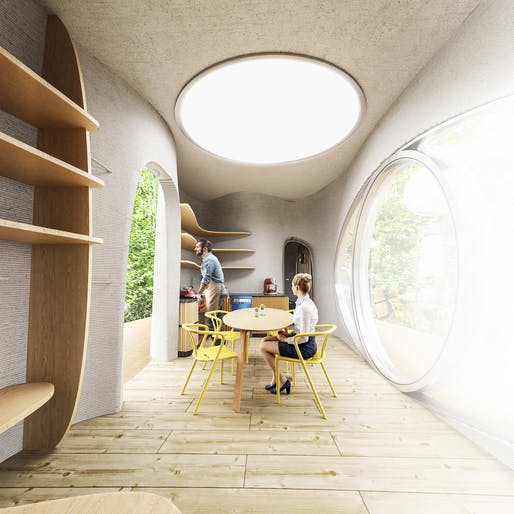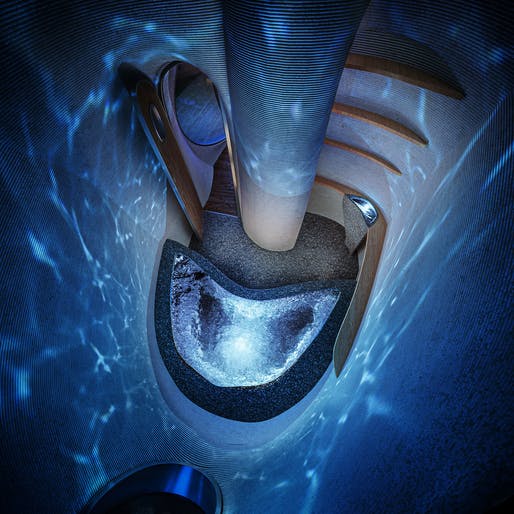The construction industry is ripe with potential for enjoying all the benefits of 3D printing—from innovative hardware and futuristic-looking robotics to complex software and a variety of materials and robust composites. The thought of an affordable, 3D-printed home is a concept that appeals to many consumers worldwide, leaving numerous developers to throw out promises for an assortment of ‘firsts,’ from homes, low-income housing developments, to villages and offices.
Now, construction developers are partnering with sculptor Michal Trpak in the Czech Republic to 3D print the “first inhabitable house.” The project, and the structure, should be complete by June. Meant to show off most of the classic perks in 3D printing, such as speed in production, lowered use of waste and carbon footprint, and affordability, the house is also … wait for it … meant to be perched atop of a boat.
“Prvok od Burinky (Protozoon) will have three rooms — a bathroom with toilet, living room with a kitchen and a bedroom,” explains the project announcement. “The building will be anchored on a pontoon and is a year-round livable house. “The house offers eco technologies such as recuperation, recirculation shower, remote control, green roof, as well as reservoirs for drinking, utility and sewage water.”

Prvok (Protozoon) will be built in the Czech Republic this June. All images courtesy of Stavební spořitelna České spořitelny (Buřinka).
3D printing of the 43 sqm / 463 square-foot structure is projected to take 48 hours, with the entire building to be finished in two months.
“The robot itself is a Czech innovation from the workshop of Trpak’s other initiative Scoolpt. A young architect and programmer Jiri Vele programmed an automotive robot for 3D printing concrete.
“Scoolpt, in collaboration with Master Builders Solutions (BASF), developed a new concrete mixture for printing that is enriched with nano-polypropylene fibers, plasticizers that improve plasticity and produce better organic shapes, and a setting accelerator. This type of concrete hardens after 24 hours to standard firmness of the foundations of a classic family house (i.e. 25 MPa). After total hardening in 28 days, the concrete acquires the values (65 MPa) — the same as in bridges.”
Some developers have already focused on additive construction at a large scale, with Italy’s WASP serving as a perfect example—and also responsible for many different projects and collaborations using cement, locally sourced clay, and other mixtures. The use of concrete, accompanied by 3D printing and additive manufacturing processes allows for a host of new techniques.
These materials are currently the focus of many scientists, too, centered around the impressive evolution of such methods in construction, and even the potential for use in space.
What do you think of this news? Let us know your thoughts; join the discussion of this and other 3D printing topics at 3DPrintBoard.com.
[Source / Images: Archinect]Subscribe to Our Email Newsletter
Stay up-to-date on all the latest news from the 3D printing industry and receive information and offers from third party vendors.
You May Also Like
New Report: Semiconductor Industry to See $1.4B in 3D Printing Revenues by 2032
“The semiconductor sector has become the most strategically significant area of global industry.” Truer words are hard to come by when it comes to the modern world, and they are...
Will Photonic-Crystal Lasers Revolutionize 3D Printing?
Powder bed fusion (PBF) for metals and polymers predominantly utilizes lasers as the primary heat source. Some directed energy deposition (DED) technologies also employ lasers, while various vat polymerization methods...
3D Printing Unpeeled: Orbex Investment, IndoMIM and HP, Ultrasonic Waves
INDO-MIM has bought three HP Metal Jet S100 printers, operating two in India and one in Texas. This is a win for HP because the company has deep experience in...
3D Printing Webinar and Event Roundup: April 21, 2024
It’s another busy week of webinars and events, starting with Hannover Messe in Germany and continuing with Metalcasting Congress, Chinaplas, TechBlick’s Innovation Festival, and more. Stratasys continues its advanced training...


































